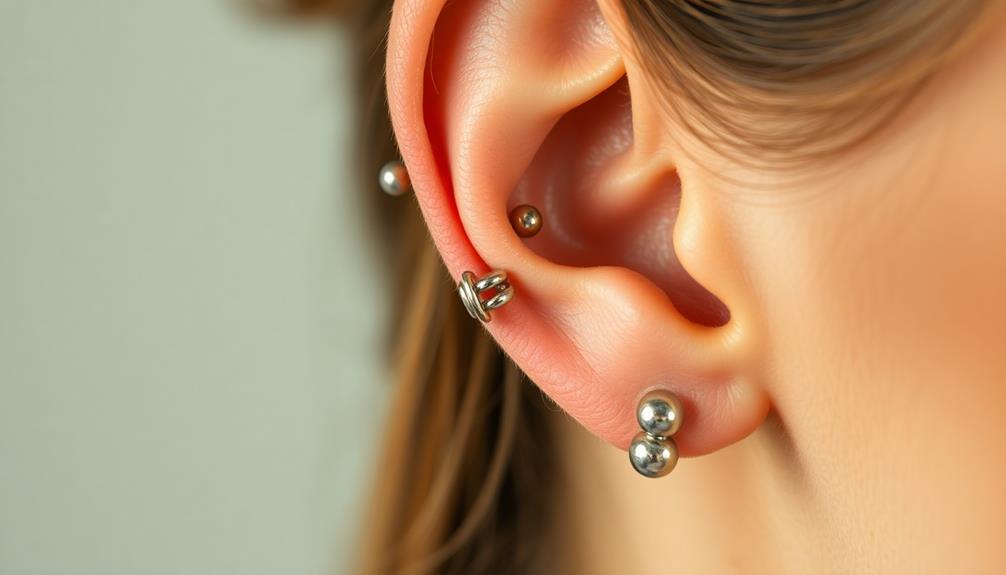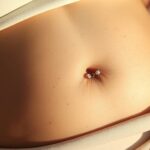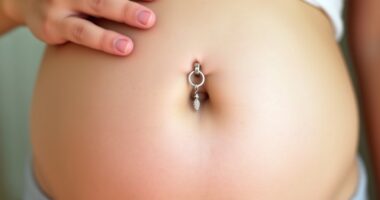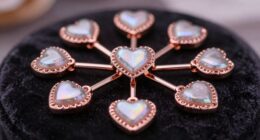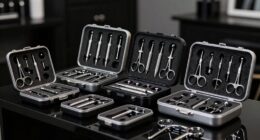If you're a new mother with nipple piercings, you need to be aware of a few important factors. Nipple piercings can complicate breastfeeding by affecting milk flow and increasing infection risks. It's essential to remove your jewelry before nursing to guarantee proper latching and prevent choking hazards. Monitor your milk flow and be cautious of any signs of infection or sensitivity during breastfeeding. Hygiene is critical—always wash your hands before nursing and clean your jewelry regularly. Proper aftercare and guidance from healthcare providers can help manage these challenges. Discover more insights on successfully handling breastfeeding with piercings.
Key Takeaways
- Nipple piercings can complicate breastfeeding if not fully healed, increasing the risk of infections and affecting the baby's latch.
- Jewelry may obstruct milk ducts, leading to issues like engorgement; removal during breastfeeding is recommended to ensure safe and effective feeding.
- Increased sensitivity and irritation may occur due to nipple piercings, necessitating regular monitoring and adjustments for a comfortable breastfeeding experience.
- Prompt medical attention is crucial for signs of infection or complications, such as persistent redness, swelling, or pain following breastfeeding.
- Consulting lactation experts and joining support communities can provide valuable advice and shared experiences for breastfeeding mothers with piercings.
Safety of Nipple Piercings

When it comes to nipple piercings and breastfeeding, safety is a top concern. The healing process of your nipple piercings plays a significant role in determining whether you can safely breastfeed. If your piercings aren't fully healed, complications could arise.
Jewelry can hinder your baby's latch, creating choking hazards and potentially causing soft tissue damage in their mouth. It's best to remove nipple jewelry entirely during breastfeeding to prevent obstruction of milk flow and minimize the risk of infections like mastitis or abscesses.
The longer it's been since you got pierced, the better your breastfeeding outcomes may be, as scarring and complications tend to lessen over time.
Professional piercers often advise against nipple piercings during pregnancy or breastfeeding due to hormonal changes that can affect healing. If you have concerns, consult a lactation consultant who can provide personalized advice.
Prioritizing safety guarantees a smoother breastfeeding experience for both you and your baby, so keep these factors in mind when considering nipple piercings. Remember, your health and your baby's wellbeing come first.
Effects on Milk Flow

Nipple piercings can impact milk flow in various ways, and understanding these effects is vital for breastfeeding success. For breastfeeding mothers, nipple piercings might lead to abnormal milk production due to potential damage or scarring of milk ducts. This could complicate your breastfeeding journey.
In some cases, you might experience increased milk flow, which could overwhelm your infant as they struggle to manage the faster flow.
Additionally, milk leakage from piercing holes is a possibility, but focusing on proper latching techniques can help mitigate this issue. However, it's important to be cautious, as jewelry prior to breastfeeding could obstruct milk flow. The presence of jewelry may block the ducts responsible for transporting milk from your breast, leading to blocked milk and further complications.
That said, not all individuals with nipple piercings face negative effects on milk flow. Many breastfeeding mothers successfully navigate this experience without complications.
It's essential to monitor your body's response and consult with a lactation expert if you encounter challenges. Always prioritize your comfort and your baby's feeding needs to guarantee a successful breastfeeding experience.
Jewelry Removal Guidelines

Before breastfeeding, it's important to remove any nipple jewelry to guarantee your baby can latch properly and avoid choking hazards. As a breastfeeding mother, prioritizing your baby's safety is significant. Here are some guidelines to follow:
- Remove Nipple Jewelry: Always take out your nipple piercings before each breastfeeding session. This prevents any potential choking hazards and assures a proper latch for your baby.
- Practice Hand Hygiene: Wash your hands with unscented soap before touching your nipples or jewelry. This step is necessary to prevent infections and keep both you and your baby healthy.
- Consider a Flexible Retainer: If you plan to keep your jewelry out for extended periods, consider using a flexible retainer. This option helps maintain the integrity of your piercing without compromising safety during breastfeeding.
Remember to handle your jewelry carefully and clean it thoroughly before reinserting it after feeding.
Frequent removal may cause the piercing to close, but your baby's comfort and safety should always come first.
Healing and Aftercare

Removing jewelry is just one part of the process; proper healing and aftercare for your nipple piercings are vital, especially during breastfeeding.
The healing times for nipple piercings can range from 6 to 12 months, so it's important to wait until they're fully healed before breastfeeding. This minimizes risks of scarring and milk flow obstruction.
During this period, focus on aftercare to guarantee a smooth breastfeeding experience. Clean the nipple with a saline solution or mild soap regularly to prevent infections.
Always wash your hands with unscented soap before handling your pierced nipples; this reduces the risk of transferring bacteria.
Keep an eye on the piercing site for signs of infection, such as increased pain, swelling, or pus. If you notice any of these signs, seek medical attention promptly to maintain your breastfeeding success.
If you need to remove jewelry frequently, consider using flexible or silicone retainers. These can help prevent the piercings from closing while promoting a safe breastfeeding experience.
Prioritizing proper aftercare will help you navigate the challenges of body piercings and breastfeeding more effectively.
Complications to Monitor

When you have nipple piercings while breastfeeding, it's essential to monitor for complications.
Watch for signs of infection, like increased pain or swelling, and pay attention to any changes in milk flow.
You should also be aware of sensitivity or discomfort, as these can impact both you and your baby.
Infection Risks
Though nipple piercings can be an expression of personal style, they come with increased infection risks, especially during breastfeeding.
It's vital to monitor for potential complications that can arise from these piercings. Infections can develop if proper aftercare isn't followed, leading to issues like mastitis, which affects breast tissue.
Here are three important symptoms of infection to watch for:
- Increased pain and swelling around the piercing site.
- Pus discharge or noticeable redness that doesn't improve.
- Flu-like symptoms or fever, which may indicate a more serious infection.
If you experience any of these symptoms, reach out to your healthcare provider immediately.
Remember, the presence of scar tissue from nipple piercings may obstruct milk flow and contribute to clogged milk ducts, further increasing infection risks.
Prompt medical attention can help prevent complications and support successful breastfeeding outcomes.
Keeping the piercing area clean and monitoring for changes will aid in minimizing these risks, ensuring a healthier experience for you and your baby.
Milk Flow Issues
Infections aren't the only concern with nipple piercings during breastfeeding; milk flow issues can also arise. Nipple piercings may alter your milk flow patterns due to scarring that can obstruct milk ducts and affect the milk ejection reflex. You might notice an increased milk flow, which can overwhelm some infants, requiring you to adjust breastfeeding positions to manage the flow effectively.
You should also be aware that milk leakage from piercing holes can occur. Thankfully, this is usually manageable with proper latching techniques and the use of breast pads between feedings.
However, keep an eye out for blocked ducts caused by jewelry or scar tissue, as these can lead to complications like mastitis. Symptoms of mastitis include fever and localized breast pain, which need prompt attention.
Monitoring for signs of nipple trauma, such as increased soreness or sensitivity during breastfeeding, is essential for early intervention.
Sensitivity and Discomfort
While nipple piercings can add a unique touch to your body art, they may also lead to increased sensitivity and discomfort during breastfeeding. You might experience pain or irritation, which can complicate the breastfeeding process.
It's important to stay vigilant and monitor your body for any signs of complications. Here are three key areas to watch:
- Sensitivity and Pain: Tugging from your baby while nursing can heighten nipple sensitivity or cause pain, especially if you're wearing jewelry.
- Scar Tissue Effects: Scar tissue from healing piercings can impact milk flow and might lead to blockages, resulting in engorgement or painful milk ducts.
- Infection Signs: Keep an eye out for persistent redness, swelling, or discharge, as these could indicate infection. Prompt action can prevent further complications.
Regularly evaluate your nipple area for any unusual changes or discomfort. Addressing sensitivity and discomfort early on guarantees both your comfort and successful breastfeeding.
Hygiene Practices for Nursing

Maintaining proper hygiene practices during nursing is vital for both you and your baby. Before you begin breastfeeding, make certain to wash your hands thoroughly with unscented soap. This helps prevent transferring bacteria that could lead to infections.
Additionally, clean the nipple area with warm water and mild soap both before and after breastfeeding to maintain hygiene and minimize irritation around your nipple piercings.
It's important to remove your nipple jewelry prior to nursing. This not only eliminates choking hazards for your infant but also facilitates better latching during lactation. Store the removed jewelry in a clean, safe place to avoid contamination and loss. Before reinserting it, verify you clean the jewelry with an antiseptic solution.
While nursing, stay vigilant and monitor the pierced area for any signs of infection or irritation. Look out for symptoms like increased redness, swelling, or discharge. If you notice any of these signs, consult a healthcare provider promptly.
Professional Guidance and Support

When you're managing breastfeeding with nipple piercings, seeking professional guidance can make a significant difference in your experience. Consulting a lactation consultant is crucial, as they can offer tailored advice on potential complications and help guarantee your breastfeeding journey is successful.
Here are three key resources to take into account:
- Lactation Consultants: They specialize in breastfeeding techniques and can guide you on how nipple piercings may affect milk flow and infant latching.
- Healthcare Providers: They'll provide information on proper hygiene practices for your piercings and breastfeeding, minimizing the risk of infections and complications.
- Professional Piercers: They can advise you on the best jewelry materials for lactation and whether you should remove your piercings before nursing.
Additionally, connecting with support groups for breastfeeding mothers can be invaluable. These groups share experiences and peer support, helping you navigate the unique challenges posed by nipple piercings.
Personal Experiences With Piercings

You might find that your journey with piercings while breastfeeding comes with unique challenges and insights from others in the community.
Many mothers share their personal stories, revealing how their experiences with healing and latching vary.
It's important to connect with those who've navigated similar paths and to seek support when needed.
Healing Journey Challenges
While many mothers cherish the bonding experience of breastfeeding, traversing the healing journey after nipple piercings can present unexpected challenges.
The healing time for nipple piercings typically ranges from 3 to 6 months, and if they aren't fully healed, you might encounter complications during breastfeeding.
Here are three key challenges you might face:
- Increased Sensitivity: You may experience discomfort during breastfeeding due to scarring or changes in your nipple tissue from the piercings.
- Milk Flow Issues: Scarring can potentially block milk ducts, leading to clogged ducts or even mastitis, which can impact your milk supply.
- Latch Difficulties: The presence of jewelry may interfere with your baby's latch, causing discomfort for both you and your little one.
Proper aftercare and hygiene during the healing process are critical to preventing infections and complications that could affect breastfeeding.
Be attentive to your body's signals and consult healthcare professionals if you notice any signs of distress, as addressing these challenges early can make a significant difference in your breastfeeding journey.
Supportive Community Insights
Many mothers in supportive online communities share their positive experiences with breastfeeding after nipple piercings, revealing that with the right approach, challenges can be managed effectively.
Many women report successful breastfeeding by removing jewelry before nursing, ensuring a proper latch and positioning. This simple step minimizes complications and fosters a comfortable breastfeeding relationship.
Personal experiences in these communities highlight how mothers with healed piercing holes can nurse without issues. They often recommend using nursing pads to manage milk leakage, which can boost your confidence while breastfeeding. This proactive measure allows you to focus on enjoying the moment with your baby rather than worrying about messes.
Consulting lactation specialists is another common piece of advice shared among mothers. They provide tailored strategies to address unique challenges posed by nipple piercings, ensuring that you feel empowered in your breastfeeding journey.
The shared knowledge and experiences in these communities create a supportive atmosphere that encourages mothers to embrace their choices regarding piercings. By connecting with others who've navigated similar situations, you can gain insight and reassurance, making your breastfeeding experience a positive one.
Personal Stories Shared
Amid the diverse experiences shared by mothers with nipple piercings, personal stories reveal a tapestry of triumphs and challenges in breastfeeding. Many mothers successfully navigate breastfeeding with piercings, showing that they don't universally obstruct milk flow.
However, there are some significant considerations to keep in mind, especially regarding the emotional and social impacts of personal choices during this time navigating personal choices.
- Remove Jewelry: Before nursing, it's essential to take out any jewelry to prevent choking hazards and facilitate better latching for your baby.
- Adjust Nursing Positions: Some mothers found that exploring different nursing positions helped manage increased milk flow and leakage caused by their piercings.
- Consult Medical Advice: It's wise to seek medical advice before getting nipple piercings or breastfeeding to verify it's safe for you and your baby.
While some faced challenges like scarring affecting milk flow, many reported positive experiences after allowing their piercings to heal fully before breastfeeding.
These personal stories emphasize the importance of informed decision-making and the value of support from healthcare professionals, guaranteeing that your journey with nipple piercings and breastfeeding can be a fulfilling one.
Frequently Asked Questions
What Happens if You Get a Piercing While Breastfeeding?
If you get a piercing while breastfeeding, you risk complications like infection and scarring. It can also obstruct milk flow and hinder your baby's latch, making it challenging for both of you during feeding.
How Long After a Piercing Can You Breastfeed?
You should wait at least 6 to 9 months after getting a nipple piercing before breastfeeding. This allows time for healing and reduces the risk of complications for both you and your baby during breastfeeding.
Do Pierced Nipples Affect Milk Production?
Pierced nipples don't directly affect milk production since glandular tissue is responsible for that. However, scarring might block milk ducts, impacting flow. It's important to monitor any changes and maintain proper hygiene to minimize risks.
Can You Wear Piercings While Giving Birth?
You're standing at the edge, jewelry glinting like stars, yet that sparkle can become a hazard. It's best to remove piercings before labor, ensuring safety for you and your healthcare team during the delivery.
Conclusion
As you navigate the journey of motherhood, think of your body as a delicate garden. Just like tending to flowers requires care and attention, so does managing piercings while breastfeeding. By understanding the safety, healing, and hygiene involved, you can nurture both your baby and your body. Remember, every choice you make is a seed planted for future growth—so choose wisely, and your garden will flourish with the beauty of health and connection.


